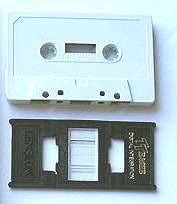Lenslok
Lenslok is a copy protection mechanism found in some computer games and other software on the 8-bit Atari computers, Commodore 64, Sinclair ZX Spectrum, Sinclair QL, MSX and Amstrad CPC. The most well-known game to use it was Elite for the ZX Spectrum.

Overview
Lenslok was released in 1985 as a plastic lens in a foldaway frame.[1] The Lenslok device was essentially a row of prisms arranged vertically in a plastic holder. Before the game started, a two-letter code was displayed on the screen, but it was corrupted by being split into vertical bands which were then rearranged on screen. By viewing these bands through the Lenslok they were restored to their correct order and the code could be read and entered allowing access to the game. The device was small enough when folded flat to fit next to an audio cassette in a standard case.
In order for the Lenslok to work correctly the displayed image has to be the correct size. This meant that before each use the software needed to be calibrated to take account of the size of the display. Users found this setup particularly annoying, at least in part because they found the instructions that were initially shipped unclear. Additionally, the device could not be calibrated at all for very large and very small televisions, and some games shipped with mismatched Lensloks that prevented the code from being correctly descrambled. The Lenslok system was not used in later releases of Elite.
The Lenslok copy protection system for the Commodore 64 version of Elite was very easy to bypass because a bug existed where the letters 'A' and 'D' were always the first combination generated by Lenslok. A simple crack, where the letters were input during the copy protection check by adding a few lines of machine language code, was effective in defeating Lenslok.
Usage issues
Dan Whitehead of Eurogamer explains that Lenslok was difficult to operate with difficult instructions, requiring recalibrations, and sometimes didn't work at all, including with screen sizes too large or too small. Whitehead notes that the "problems with Lenslok were undoubtedly exaggerated".[1] Pavel Barter of GamesRadar similarly notes that Lenslok didn't work on some screens.[2] In the end, Lenslok was used only on 11 releases.[1]
Software
Software that used the Lenslok system:
- ACE, released by Cascade Games
- Elite, released by Firebird
- Fighter Pilot, released by Digital Integration
- Jewels of Darkness, released by Level 9 Computing
- OCP Art Studio, released by Rainbird
- The Price of Magik, released by Level 9 Computing
- Silicon Dreams, released by Level 9 Computing
- Supercharge, released by Digital Precision
- Tomahawk, released by Digital Integration
- TT Racer, released by Digital Integration
See also
References
- Lenslok Instruction Sheet (PDF file)
- Bird Sanctuary - Lenslok Article containing further details on Lenslok, with photographs.
- LensKey A Lenslok emulator allowing access to emulated versions of the games.
- CRASH 26: LOKed OUT?
- Sinclair user 48 letters: Lenslocked out